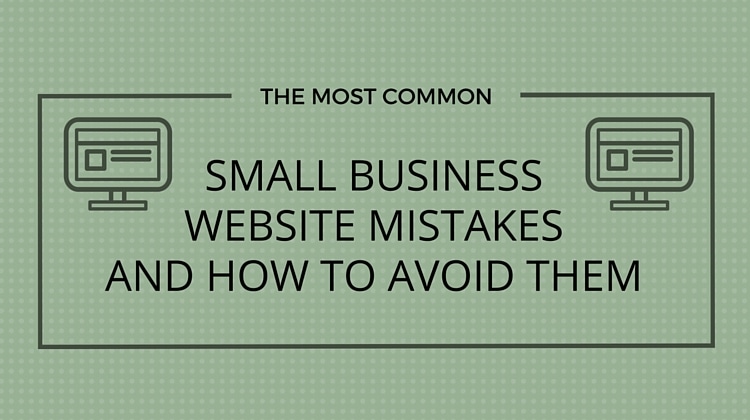
What is it? Most businesses own one, yet it doesn’t do anything for them.
A website is an essential marketing tool that each and every small business must have. A website is generally the place where potential customers have their first contact with your business. Therefore, your business can’t afford to risk leaving a bad impression there.
Business owners often settle for websites that under-perform. This translates into great losses every year. This article outlines some of the most common small business website mistakes as well as a few suggestions of how to avoid them.
Mistake 1: Incorrect Contact Information Displayed
It’s important for your website to show your contact details loud and clear. Visitors should easily find multiple ways to contact your business. The more difficult it is to find your contact information, the less likely prospects will contact you.
Most importantly, you need to have a “Contact” or “Contact us” page. Your Contact page should include your:
- Phone number
- Fax number if your business uses one
- Mailing address
- Physical address, if different from mailing address
- Map of your address
- Contact form – don’t just list your email address. It looks amateurish.
- Link to your social accounts such as Facebook, Twitter, LinkedIn, etc.
In addition, your phone number should be in the header area of your website. Your physical address should be in the footer area of your website with a link to your “Contact” page. That way, prospects can easily find your contact information on any page of your website. Make sure your phone number is clickable for mobile users to call you when they need to.
Mistake #2: Your Website isn’t Mobile-Friendly
This is another one of the greatest small business website mistakes. Currently, there are still many websites that have not been optimized for mobile browsing. You should not create a website that can only be viewed from desktop devices. In today’s world, internet users are using a variety of devices to access the web—from mobile phones, tablets, gaming consoles, and most recently, smart watches.
Visitors who try accessing websites that have not been mobile optimized, are likely to face a variety of issues. Text might appear illegible forcing visitors to extend the screen and scroll horizontally. Navigation keys might be too small to click from mobile devices. Prospects might also find it difficult to exit your site since the close button might be out of reach on their mobile screens. Visitors who encounter these issues are likely to leave your site in seconds and never visit it again.
Another problem is that Google’s search algorithm now assesses and ranks websites based on how compatible they are with mobile devices. Therefore, if your website isn’t mobile-friendly, Google is likely to rank it lower. This will in turn affect the online visibility of your business and the amount of search traffic it gets.
If you’re not certain whether your website is mobile optimized or not, you can use Google’s Mobile Friendly Test to check. You just have to type in your website’s URL and Google will check its compatibility with mobile devices.
Mistake #3: Lack of a Clear Call-to-Action
Once your site has caught a visitor’s attention, it’s time to tell the visitor what to do next—what it is that you want them to do. If they lack this information, they’re likely to get frustrated and confused. This is because they might be overwhelmed with too many options to choose from.
When visitors land on your website you have to tell them what you want them to do. This can be achieved with a clear and noteworthy call to action that directs visitors’ focus to the next step.
Ask yourself these questions: What do I need clients to do? Do I need them to call, purchase my product, get in touch with me, subscribe to my email list, download a report, or maybe something else? Asking these questions will help you determine the appropriate call to action for each of your web pages.
Mistake #4: Website Content is Not Well-Organized
Arranging your website content properly is important as it keeps visitors engaged. Proper arrangement does not mean placing everything about your business on your home page. That would just create an overcrowded home page, overwhelming your site visitors.
When a visitor lands on your website, she knows nothing about your business. Her goal is to get as much information as possible about your business as easily as possible. This implies that you have to create your content using terms and phrases that interest potential clients. These terms and phrases should also be easily scannable.
Your content should be broken into smaller pieces by using bullet points. Important points can be written in bold to attract the eye. Keep in mind that users won’t read an mass of content under any circumstances. Therefore, present your information in a scannable way. The content throughout your website should be scannable and easy to understand. Products and services should be explained in simple terms that are easily understood by customers.
Conclusion
As long as you avoid the above small business website mistakes, your company can have a great website. For many businesses, a website is just another expense. The small percentage of businesses with great websites realize that it’s a great way to grow their companies. From day one, treat your website as a revenue-producing extension of your business.


Could not stress the importance of #3. Still trying to do A/B testing to find out which call to action buttons work. Another thing I noticed with small business clients’ website is that it is too crowded with content – good content, yes – but too long for a potential user to skim and get to the important information quickly. Thanks for these tips, Monika!